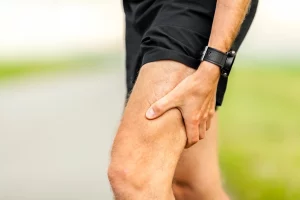Hi, David Fitzgerald here from Dublin Physiotherapy. In last week’s video, you may remember we mentioned that a large proportion of the population will have apparent signs of a disc bulge on an MRI scan and yet not be symptomatic. I’d like to follow up on that this week because it obviously begs the question: how do we determine whether a so-called positive finding on an MRI of a disc bulge is a relevant feature or just an incidental variable? Of course, this is a critically important matter.
Many of you will be familiar with a full-blown disc protrusion, which typically causes sciatic pain – nerve pain radiating down the leg, usually on the back of the leg, hence the name sciatica. It’s from the sciatic nerve entrapment, but you can also get pain down the front of the leg from entrapment of the femoral nerve, which is another nerve that comes off the upper part of the lower spine. Either way, these two scenarios represent pinching or trapping of the nerve, and one of those mechanisms is a bulging disc. Now again, a large proportion of people who have intermittent sciatica don’t require a surgical solution to decompress the nerve. About ten to fifteen percent of patients with persistent sciatic pain need surgical decompression, leaving 85 percent that can be managed conservatively or whose symptoms resolve with varying combinations of anti-inflammatories, rest, rehabilitation, physiotherapy, and so on.
So, when we have a disc bulge of significant size compressing a nerve, there’s a fairly typical symptom presentation, and people are usually quite limited in their function. However, before a disc bulges to that extent that it causes compression on the nerve, you may get modest amounts of bulging which just cause intermittent pressure on the nerve, sometimes with particular positions or sustained sitting. Surprisingly, a low sitting position, which seems like a relaxing position, can aggravate a disc, especially if it has been strained, irritated, or if there’s some mild degenerative change in it. It sometimes won’t tolerate the sustained load of a fixed position, and this can depend on what you’re sitting on. This can sometimes aggravate a disc, producing some extra bulging while in the position, which not only causes soreness in the spine but also intermittent pressure on the nerve. This pressure usually goes away with a change of position. So, these patients are usually what you might call ‘walking wounded’. They’re uncomfortable after a given period of time, but once they get up, move, and change position, the mechanics of the disc decompress and it takes the pressure off the nerve. At least from a clinical point of view, we know that the disc, although under pressure, hasn’t become completely dysfunctional or ruptured. Incidentally, the phrase ‘slipped disc’ really means that the casing or the outer wall that surrounds the disc has become dysfunctional or torn, and the material from the inner central part of the disc has actually pushed through and squashed its way out. That’s what is known as a full-blown slipped disc or disc protrusion in medical terminology.
But obviously, there are lots of stages of disc soreness that fall just short of that full scenario we’ve just described. People who have had intermittent low back pain over a long period of time without any symptoms in the leg can confidently conclude that there’s no pressure on the nerve, and that generally means they’re not really suitable candidates for surgery. Surgery in the spine is largely a decompression procedure; it’s to try to remove material that’s compressing the nerve. It doesn’t really do anything to address painful structures in the spine, and that’s important because people often, who have quite debilitating back pains, hope for a surgical solution because it’s a radical kind of intervention. But the criteria for surgical decompression must be persistent compression of the nerve and/or spinal cord, which is a more serious type of nerve compression.
People who’ve had intermittent symptoms over a long period of time can also get nerve irritation, but usually, in that situation, they don’t get much back pain with it. We often see people in the clinic where they might start off with an acute episode of low back pain that’s very debilitating, may settle in a couple of days, and then becomes a recurrent thing. Usually, as time goes by, the episodes get a bit more severe and sometimes a bit more frequent, and then sometimes they don’t fully recover, leaving a residual deficit. They find that they don’t like bending, lifting, carrying things, or sitting for long periods. This tells us that the tissues are slowly adapting over time in a negative way. It’s important to try to interpret this because when we’re working through rehab, we need to try and control the loading on the disc. You can’t avoid loading it with daily living, but it’s about trying to reintroduce loads and see if the disc and the rest of the tissues can actually accommodate physical loading, which is part and parcel of daily living.
At the very end of the spectrum, usually people over 60, who have well-established degenerative changes in joints, often don’t get much pain in the back. But because the bulging disc is now no longer a soft, jelly-like material but rather described as a leathery tissue, often becoming very solidified, almost bony, it’s not a painful structure in its own right. However, those little pieces of bone, which essentially were disc material that over time have become hardened and turned into bone, are known as osteophytes. They can cause intermittent pressure on the nerve, typically in certain positions, often lying down at night. Surprisingly, you would imagine there wouldn’t be much pressure on the spine, but the change in angle as you lie, particularly on your sides, can cause these osteophytes to pinch on the nerve. Once you start to get nerve pain, it’s quite an unpleasant sensation. There are a few other kinds of presentations and ways in which a disc tells us that it’s irritated.
Usually, one of the things we look out for is an intolerance for static loading, whether that’s sustained standing or sitting. That’s one important measure. Whether extra loads or repeated bending tend to make it worse can also be a feature that tells us the disc is irritable. If folks tend to be
stuck in a bent position or shifted off to one side, these are often indicators that there is some inflammatory process going on within the disc. It hasn’t necessarily become completely ruptured or dysfunctional, but it’s under pressure, and that’s obviously an important sign. Now, the plus side of all this is that, depending on the stage of the situation, there’s usually good potential for reversibility.
Usually, from a treatment point of view, this means ensuring that the mechanics of the lumbar spine are functioning properly and that all of the segments in the spine are moving properly. Very commonly, people will have significant stiffness in areas above the symptomatic level of the symptomatic disc, and it’s the stiffness in the other segments that keep shunting the pressure onto this area. Physical treatments need to improve mobility in these areas. I often describe it to patients as like getting more mobility in rusty links in a bicycle chain, simply to try to redistribute the pressure. Postural alignment is another important factor. Muscle tone, both core muscle strength and general hip and pelvic girdle strength, are also very important factors for ensuring that the muscles are taking their fair share of the load. There’s a lot of detail involved in how one tries to evaluate that.
But we’ll probably come back and talk about this a little bit more next week because there is, I say, a big spectrum, and people are always aware of the severe end of the spectrum. But there’s a lot of people in that midsection, and they’re not necessarily sure what to do. They may be a little concerned if they had an MRI scan that shows some evidence of a bulge, but it doesn’t necessarily mean that one has to completely adapt and modify your lifestyle around it, simply because the scan shows a bit of a bulge. That’s pretty normal in the kind of cases we see at Dublin Physiotherapy. Hope you enjoyed the information. We’ll see you again in another video. Bye for now.”





